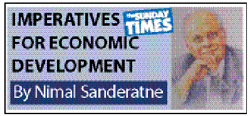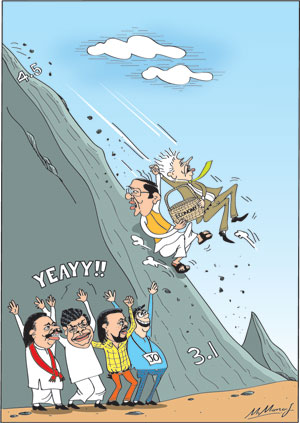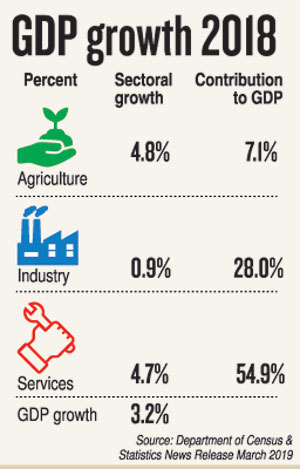Columns
The unforeseen slowing down of the economy in 2018
View(s): Economic growth of only 3.2 percent in 2018 is much lower than was expected at the beginning of the year. The economy was expected to revive from the low economic growth of 3.1 percent in 2017 to about 4 percent. Last year’s economic growth was below the annual average growth of the post-independence years (1950-2017) of about 4.5 percent.
Economic growth of only 3.2 percent in 2018 is much lower than was expected at the beginning of the year. The economy was expected to revive from the low economic growth of 3.1 percent in 2017 to about 4 percent. Last year’s economic growth was below the annual average growth of the post-independence years (1950-2017) of about 4.5 percent.
In contrast, the South Asian region that has the highest growth in the world is growing at a little over 7 percent. Economic growth of Bangladesh is twice that of Sri Lanka.
Growth in perspective
Last year’s economic growth of only 3.2 percent was lower than expected and one of the lowest rates of economic growth in recent years. It is comparable to the low growth in the economy during the 1988-89 insurgency and the years of energy shortages in the 1990s.
Sri Lanka’s economic growth performance over the years has been much lower than the country’s potential. Last year‘s economic growth, as well as the 3.1 percent growth of 2017, were below the annual average growth of 4.5 percent in the post-independence years (1950-2017) and that of the last decade.
Political chaos
Much of the poor performance of the economy in the fourth quarter, which was expected to be one of economic revival, is attributed to the October-December political anarchy. While this is, no doubt, correct, it would be incorrect to characterise the economy prior to the political anarchy as a robust one.
In fact, political disunity and lack of a consensus on economic policies hampered the country’s economic performance since 2015. The October political chaos aggravated it. This year’s economic performance, too, would be affected by political uncertainty.
Economic performance
Last year’s economic growth of 3.2 percent was achieved by a 4.8 percent growth in Agriculture, a 0.9 percent increase in industry and by a 4.7 percent growth in services.
The growth in agriculture marked a revival from drought ridden conditions in previous years. The growth of only 0.9 percent in industry (that includes construction) was a continuation of a downward trend in recent years due to lower construction, rather than a dip in manufactures. There was a strong growth in services by 4.7 percent that was an acceleration of the growth trend in services in recent years.
 Agriculture
Agriculture
The Agricultural sector grew by 4.8 percent, recovering from severe floods and droughts, which set back agricultural production from the latter part of 2017. The improved performance was mainly due to increased production of rice by 33.9 percent. In addition, fruits, freshwater fish, coconut, spices, animal production, cereals and vegetable production, too, increased. On the other hand, there was a decrease in production of some agricultural activities such as tea, rubber, marine fish, forestry and logging.
Agriculture’s share in GDP
Agriculture’s contribution to GDP that has been declining with the diversification of the economy rose marginally to 7.0 percent of GDP last year. However, it was lower than the pre-drought period when agriculture contributed 8 to 9 percent of GDP.
This fall in the contribution of agriculture to GDP is a feature of economic development due to diversification of the economy. However, this decline in Sri Lanka has occurred owing to a poor performance in agriculture as well. There is a need and potential to increase agricultural production to enhance exports, increase import substitution and for the country’s economic development.
Industrial sector
The performance of the manufacturing or industrial sector has been disappointing. The Industrial sector, which contributes 28 percent to GDP, grew by a mere 0.9 percent in 2018. Manufacturing grew by 3.0 percent during the year mainly due to increased production of food, beverages and tobacco, textiles and wearing apparels and the manufacture of basic metal and fabricated metal products, manufacture of other non-metallic mineral products and manufacture of rubber and plastic products that have increased significantly.
However, manufacture of coke and refined petroleum products and manufacture of paper products and machinery and equipment decreased. While electricity, gas, steam and air conditioning, water collection, treatment and supply recorded a growth of 4.1 percent and 4 percent, respectively, mining and quarrying declined by 5.1 percent during 2018.
Most significant was the continued decline in construction, which contributes 7.3 percent to GDP. Construction contracted by 2.1 percent to drag down industrial production.
 Services
Services
The Services sector that is the largest contributor to GDP of 54.9 percent grew by 4.3 percent in 2018, largely due to growth in financial services by 12.6 percent and Insurance, reinsurance and pension funding by 22.4 percent.
Among services there was significant growth in financial services, information technology services, insurance, telecommunications, accommodation, food & beverage serving, wholesale and retail trade and personal services that grew at high rates of growth. Public administration and defenee activities have however declined by 7.0 percent and 0.6 percent, respectively, in 20 18.
Favourable developments
In this somewhat depressing account of the last year’s economic performance, there were some significant bright spots. These were the boost in tourism and exports.
Tourism
Although tourism was severely affected at its boom time by the political crisis in October, there has been a restoration. Despite the setback in October-December, tourist earnings increased to a massive US$ 4.38 billion.
Exports
In 2018, exports grew by 4.7 percent on top of a 10.3 percent growth in 2017 to reach US$ 11.9 billion. Industrial exports increased by 8.4 to US$ 9.3 billion. These are favourable developments that are only partially captured in the GDP estimates.
Concluding reflection
While the South Asian economic growth is the highest in the world at slightly over 7 percent, Sri Lanka’s GDP grew by less than half that at only 3.2 percent, which is one of the lowest rates of growth in recent decades. Although this dip in economic performance is attributed to the 52 days of political anarchy of October, it is only partly correct. The reasons for the slow growth are much broader.
The constitutional crisis of October 2018 was a culmination of an unworkable coalition that had no consensus on economic policies or a concerted will to implement them. Consequently there was no business confidence among either locally or among international investors. That is a root cause for the sluggish economic performance from 2015.
In addition, the government was preoccupied with political issues rather than effective implementation of economic policies. Distractions of the bond scam, widespread corruption and violent political opposition to economic policy implementation hampered economic development. There were also international factors such as the appreciation of the US dollar, rise in international interest rates and a fuel price hike that affected the economy adversely.
Recent economic performance has been inadequate and below potential. Sri Lanka has become a slow growing economy in Asia.


Leave a Reply
Post Comment